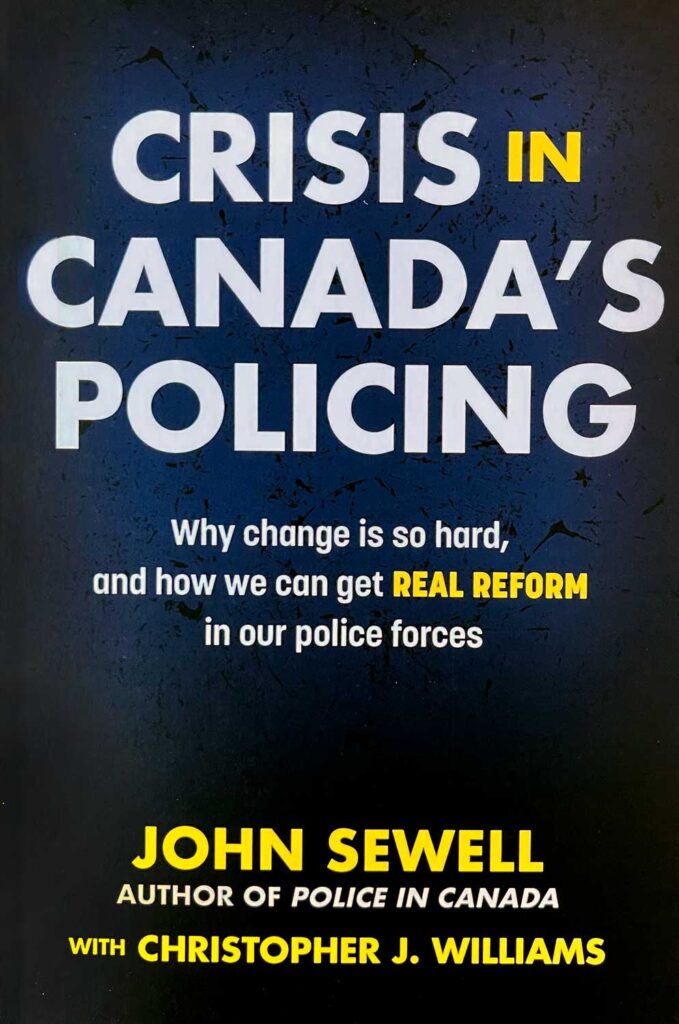
Crisis in Canada’s Policing (2021)
James Lorimer and Company
Crisis in Canada’s Policing, the new book by John Sewell with Chris Williams, describes the state of large Canadian police forces after the murder of George Floyd in May 2020. The many government reports on police over the last three decades are referenced, noting that few of their recommendations have been adopted.
Chapter 1, `Why Is It so difficult to change policing’, discusses police culture, officer solidarity in presenting evidence, excessive use of force, racism and sexism, lax reporting requirements, poor relationships with social organizations, ineffective discipline, the power of police associations, weak management and governance, and ineffective oversight. Examples are given from large police forces across Canada.
Chapter 2, `What do police do?’, addresses issues of crime data (comparing crime in large cities across the country), how police officers spend their time, measures of police efficiency including clearance rates, response time, police/population, and value for money. It looks at the usefulness (or not) of police patrol, police in crime prevention, suspect identification, pre-charge screening, police response to those in mental crisis, and the limited role police play in safety and security. Sections are included on private policing, as well as police, weapons and armour.
Chapter 3, `Systemic discrimination: police and race’, outlines the long history of racial discrimination by police, with substantial information on the discouraging history of carding and street stops in large Canadian cities, and discrimination again Indigenous persons for many decades, including incarceration rates, who gets shot by police in Canada, and racism within police forces.
Chapter 4, `Systemic discrimination: police and women’, reviews the conclusions of the Unfounded series by the Globe and Mail about police not taking seriously claims of sexual assault by women, looks at the Murdered and Missing Women report, intimate partner violence among police officers, sexual discrimination within police forces with particular attention to the RCMP, and sexual discrimination in training and promotion.
Chapter 5, `Recruitment, training and promotion’, begins by rejecting the practice of hiring general recruits, instead suggesting hiring by job description as all other large organizations do. It deals with similar methods of recruit training across the country, its impacts and limitations, and the need for further training for specific tasks. It reviews promotion practices within forces, the very limited police-controlled discipline practices, and suspension with pay (except in Alberta.)
Chapter 6, `What is to be done’, begins by discussing ideas of abolishing or de-establishing police organizations, referring to several examples of this being attempted in USA. It includes comments on demonizing those arrested, noting that studies show that most of those who are incarcerated were victims before they were arrested, and that extraordinary amounts of social sending ($7 billion a year in Edmonton) are failing to address and resolve the clear social problems which exist and need to be rethought with much more emphasis on affordable housing and income support. Ideas of defunding or de-tasking police have been considered and implemented in some jurisdictions, removing police from mental crisis, homelessness, overdose and youth calls, and thoughts are given to removing police from traffic calls, all of which will have a significant positive impact on racial discrimination by police.
Significant changes are needed to disrupt and dismantle the way policing is now delivered: collect race-based data; implement pre-charge screening; find new ways to hire staff and hire managers; make discipline procedures more independent and transparent; de-weaponize the rank and file; substantially change who sits on police boards.
The book is available at Chapters/Indigo and other bookstores. It can be ordered online at Lorimer.ca Phone orders: 1(800) 565-1975.
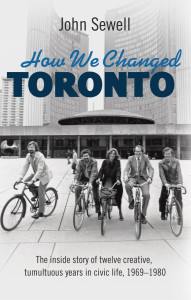 How we changed Toronto, 1969 – 1980
How we changed Toronto, 1969 – 1980
2015, James Lorimer and Company
By the mid-1960s Toronto was well on its way to becoming Canada’s largest and most powerful city. One real estate firm aptly labelled it Boomtown. Expressways, subways, shopping centres, high-rise apartments, and skyscraping downtown office towers were transforming the city. City officials were cheerleaders for unrestricted growth.
All this “progress” had a price. Heritage buildings were disappearing. Whole neighbourhoods were being destroyed — by city hall itself — in the name of urban renewal and high-rise developers.
Many idealistic, young Torontonians didn’t like what they saw. At a time when political activism was in the air, they engaged in local politics. Recently graduated lawyer John Sewell was one of many. He joined his friends working for local residents in areas targeted for demolition by city hall. Others were fighting the Spadina expressway, planned to push its way through the city to the lakeshore. Still others were saving Toronto’s Old City Hall from demolition.
This was the modest start of a twelve-year transformation of Toronto, chronicled in John Sewell’s new book. Bringing together a fascinating cast of characters — from cigar-chomping developers to Jane Jacobs and David Crombie, from a host of ordinary citizens to some of the world’s most innovative architects and planners — Sewell describes the conflict-filled period when Toronto developed a whole new approach to city government, civic engagement, and planning policies.
Sewell went from activist organizer, to high-profile opposition politician, to leading light of a bare reform majority at city hall, to become Toronto’s mayor. Along the way he sparked the rethinking of an amazing array of old ideas — not just about how cities should grow, but about race relations, attitudes toward the LGBT community, and the role of police. His defeat in the city’s 1980 election marked the end of a decade of dramatic transformation, but the changes this reform era produced are now entrenched — in Toronto, but in other Canadian cities, too.
How We Changed Toronto is the inside story of activist idealists who set out to change the world — and did, right in their own backyard
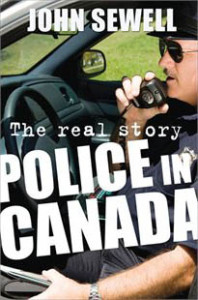 Police in Canada: The Real Story
Police in Canada: The Real Story
2010, James Lorimer and Company
What’s going on with Canada’s police? Once an institution that commanded respect and trust, the police are now widely regarded with skepticism and even suspicion. The dramatic death of Robert Dziekanski at the hands of the RCMP at Vancouver’s airport, accusations of racial profiling, and the resistance of police to independent civilian oversight have created the impression of organizations and individuals accountable to no one and above the law.
For the past twenty years, John Sewell has been an informed, independentminded observer of Canada’s police. He was an early advocate of civilian review and has urged politicians to be as tough on police spending as they are on other government departments. His first book on this subject, published in 1985, was a pioneering outside analysis of police work. Now he offers readers a book built on his research, experience, and knowledge. Police in Canada gives readers an understanding of the role of police forces that goes far beyond public relations exercises and the portrayals shown in the media.
Addressing topics that include effective recruitment and training, police culture, accountability, surveillance, the use of tasers, racial profiling, complaints against the police, private policing, and governance, Sewell draws together the most up-to-date research in order to open the door on Canada’s various police forces, including the RCMP.
His book provides the foundation for finding a new basis for police work in Canadian society.
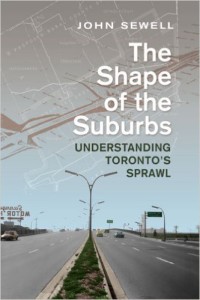 The Shape of the Suburbs: Understanding Toronto’s Sprawl,
The Shape of the Suburbs: Understanding Toronto’s Sprawl,
2009, University of Toronto Press
It is now impossible to understand major North American cities without considering the seemingly never-ending and ever-growing sprawl of their surrounding suburbs. In The Shape of the Suburbs, activist, urban affairs columnist, and former Toronto mayor John Sewell examines the relationship between the development of suburbs, water and sewage systems, highways, and the decision-making of Toronto-area governments to show how the suburbs spread, and how they have in turn shaped the city.
Using his wealth of knowledge of the city of Toronto and new information gathered from municipal archives, Sewell describes the major movements and forces that allowed for rapid development of the suburbs, while considering the options that were available to planners at the time. Discussing proposals to curb suburban sprawl from the 1960s to the recently adopted plan for the Greater Toronto area, Sewell combines insightful and accessible commentary with rigorous research on the debate between urban and suburban. Concerned not only with sprawl, The Shape of the Suburbs also demonstrates the ways in which suburban political, economic, and cultural influences have impacted the older, central city, culminating in the forced Megacity amalgamation of 1998.
Rich in detail and full of useful visual illustrations, The Shape of the Suburbs is a lively look at the construction of the suburban era.
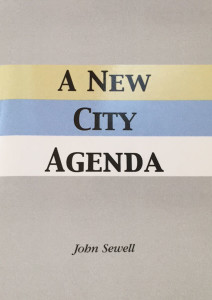 A New City Agenda
A New City Agenda
2004
(Zephyr Press)
*Out of Print
While Canadians have quickly recognized the importance of healthy cities in their own lives and communities, governments have lagged far behind. In A New City Agenda, journalist and former mayor, John Sewell answers the question: What would a new deal for cities look like? He articulates a new vision for Canada’s largest urban regions and the implementation of required changes in social services, public education, settlement, health, housing, policing, land use and governance.
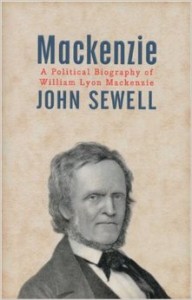 Mackenzie, a political biography of William Lyon Mackenzie
Mackenzie, a political biography of William Lyon Mackenzie
2002, James Lorimer and Company
History has often dismissed William Lyon Mackenzie as a comical figure, or as the political hothead who bungled the Upper Canada Rebellion of 1837. Former Toronto mayor John Sewell suggests he may actually be the best model this country has ever had of a responsible politician.
In Mackenzie: A Political Biography of William Lyon Mackenzie, Sewell brings the fiery politician to life. He describes his subject’s early years in Scotland, speculating about the political experience Mackenzie may have gained during the 1820 uprisings in Glasgow. He tells us about Mackenzie, feisty journalist and publisher of the Colonial Advocate; Mackenzie, first mayor of Toronto, who diligently served the city; Mackenzie, leader of the Rebellion of 1837, a man paradoxically more inclined to discussion than insurrection. Most importantly, he paints a vivid portrait of a passionate champion of a still inchoate idea — democracy. Throughout, Sewell traces Mackenzie’s attempts to grasp and understand the concept of democracy and the obligations it demands of its adherents.
Mackenzie, his political beliefs, and his experiences more than 150 years ago remain relevant to us today. This stimulating and insightful political biography comes from one of Mackenzie’s spiritual descendants and a man himself well known as a Toronto reform politician.
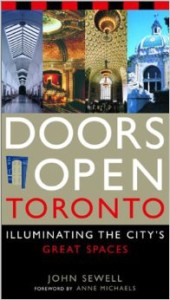 Doors Open Toronto, Illuminating the City’s Great Spaces
Doors Open Toronto, Illuminating the City’s Great Spaces
2002
(Random House)
*Out of Print
Generously illustrated with some 200 photographs and sidebars, and accompanied by seven hand-drawn maps, Doors Open Toronto is the essential book for anyone who cares about the city they live in, for lovers of secret places, for adventurers at heart.
2.5 million people live in Toronto, but how many know the stories of their city? In this accessible, lively literary companion to the Doors Open Toronto festival — now in its third year — irrepressible city advocate and former mayor John Sewell takes us on a tour of the places in Toronto every citizen or visitor should explore. Step inside the old Don Jail, with its rotunda ringed with serpents and gargoyles, once home to the infamous bank-robbing Boyd Gang, until they escaped — twice. Go to the original Don Mills to see where the lumber was sawn for the Simcoe’s 1795 country home, Castle Frank, and the paper produced for William Lyon Mackenzie’s newspaper, The Colonial Advocate. Or explore the Chapel of St. James-the-Less, with its cemetery established in response to the cholera epidemic of 1834 that killed 10% of the city’s population. Doors Open Toronto illuminates these wondrous places and nearly one hundred more, bringing life and meaning to the streets we walk down every day.
The Flatiron (Gooderham) Building, the old Don Jail, Osgoode Hall, Enoch Turner School House, One King West, Hart House, University College, St. James’ Cathedral, Gooderham & Worts Complex, George Brown House, R. C. Harris Water Filtration Plant, The Elgin and Winter Garden theatres, the Canadian Opera Company, Union Station, The Arts & Letters Club, Commerce Court North, the Design Exchange, St. Paul’s Basilica, Canada Life building, and many more…
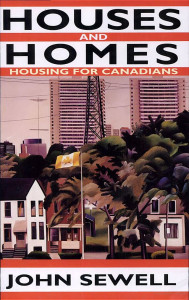 Houses and Homes: Housing for Canadians
Houses and Homes: Housing for Canadians
1994, James Lorimer and Company
In the first comprehensive book on the topic since the 1970s, former Toronto mayor John Sewell considers housing issues in Canada.
Writing in a style that is accessible and direct, Sewell considers public, private, and social housing. He looks at affordability and need, discusses definitions of good housing and good neighbourhoods, and examines the various approaches that governments have taken since World War II to increase the stock of reasonably priced housing. He shows why these approaches have consumed large amounts of public dollars yet have often failed. Indeed, homelessness is a larger problem in Canadian cities than ever before. In a time of shrinking public expenditures, he proposes the kinds of solutions necessary to ensure that all Canadians are well housed.
As chair of the Metro Toronto Housing Authority in the eighties and, more recently, as chair of the Commission on Planning and Development Reform in Ontario, Sewell has played a unique role in increasing public awareness of housing issues. His thought-provoking analysis will be of interest to all who believe that Canadians deserve affordable housing.
The Shape of the City: Toronto Struggles With Modern Planning 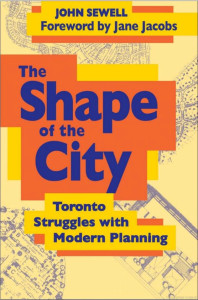
1993, University of Toronto Press
Critics have long voiced concerns about the wisdom of living in cities and the effects of city life on physical and mental health. For a century, planners have tried to meet these issues. John Sewell traces changes in urban planning, from the pre-Depression garden cities to postwar modernism and a revival of interest in the streetscape grid.
In this far-ranging review, Sewell recounts the arrival of modern city planning with its emphasis on lower densities, limited access streets, segregated uses, and considerable green space. He makes Toronto a case history, with its pioneering suburban development in Don Mills and its other planned communities, including Regent Park, St Jamestown, Thorncrest Village, and Bramalea.
The heyday of the modern planning movement was in the 1940s to the 1960s, and the Don Mills concept was repeated in spirit and in style across Canada. Eventually, strong public reaction brought modern planning almost to a halt within the city of Toronto. The battles centred on saving the Old City Hall and stopping the Spadina Expressway. Sewell concludes that although the modernist approach remains ascendant in the suburbs, the City of Toronto has begun to replace it with alternatives that work.
This is a reflective but vigorous statement by a committed urban reformer. Few Canadians are better suited to point the way towards city planning for the future.
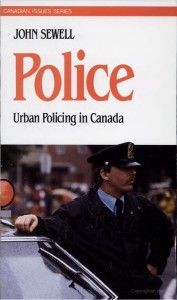 Police: Urban Policing in Canada
Police: Urban Policing in Canada
1985, James Lorimer and Company
Click here to order.
Policing is crucial to society. In the public’s mind, police stand for law and order, protecting the law-abiding from the law-breaker. But what does the police officer on the beat actually do? Does the public idea of policing fit the reality? Are the police as productive as they might be, as effective at crime fighting as we might expect?
The book begins with an outline history of policing and an exploration of the extent of crimethe principal influence on the public’s perception of police work. Sewell then turns to the day-to-day issues of policing, including the structure and content of police work; management problems; police productivity; the exercise of discretion; recruitment and training practices; police wrongdoings; the challenges posed by the rise of police unions and private policing; and proposals for reform.
First published in 1985, Police drew together all available research on policing in a readable introductory book that was the first to lift the veil on urban policing in Canada.
 Rowland Travel Guide to Toronto (with Charlotte Sykes)
Rowland Travel Guide to Toronto (with Charlotte Sykes)
1985
*Out of Print
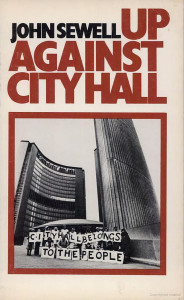 Up Against City Hall
Up Against City Hall
1972, James Lorimer and Company
During the 1960s, city politics changed dramatically in Canada. The comfortable world of old-guard municipal politics was challenged by citizen groups and reform-minded candidates.
In this book, John Sewell provides a frank, informal account of his involvement in the key issues in Toronto city politics during this period of change. The result is a valuable look at how city government really functions and how citizens and reform-minded politicians can have an impact on city hall.
First published in 1972, Up Against City Hall is a inside look at a period of remarkable change in Canadian municipal politics penned by one of the nation’s most effective reformers.
